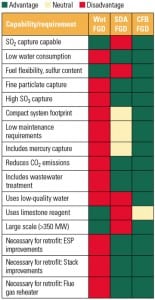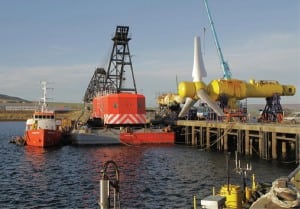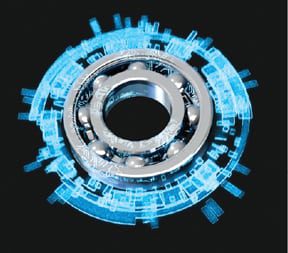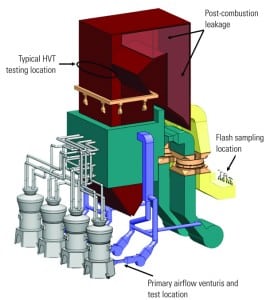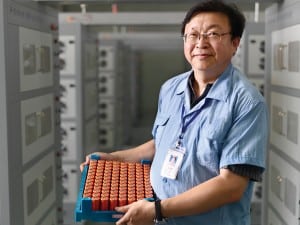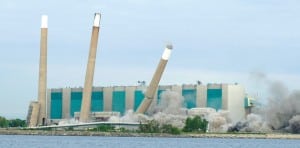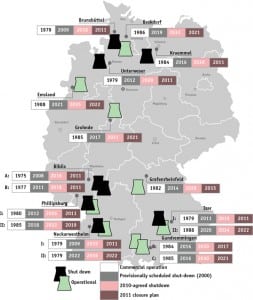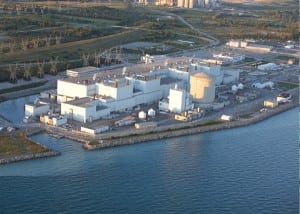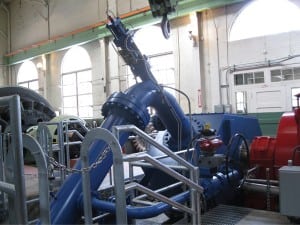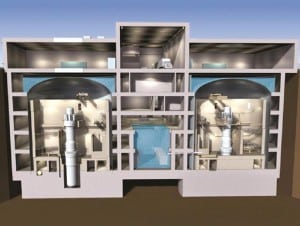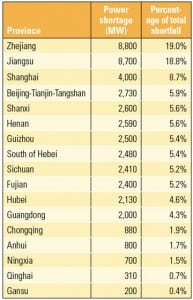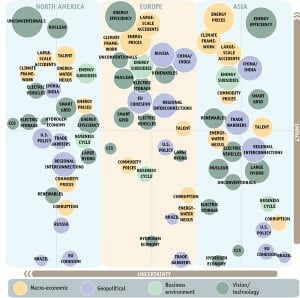In This Issue
-
Nuclear
Construction Begins at Two U.S. Nuclear Reactors
In the U.S., where construction of new nuclear reactors has stalled for three decades, two separate nuclear projects completed placement of basemat structural concrete for new AP1000 reactors a few days apart this March. SCANA Corp.’s South Carolina Electric & Gas Co. (SCE&G) marked the milestone on March 11 (Figure 2), completing concrete placement of the nuclear island basemat for its V.C. Summer Unit 2 in Fairfield, S.C., while Southern Co.’s Georgia Power completed placement for a nuclear island at its Vogtle Unit 3 nuclear expansion site near Waynesboro, Ga., on March 14 (Figure 3).
-
Coal
CFB Scrubbing: A Flexible Multipollutant Technology
The number of regulated air emission constituents is increasing while the acceptable amounts for release are decreasing. In the long run, picking the most flexible multipollutant technology is surely the least cost option.
-
Solar
Solar Thermal Gains in UAE, Spain, and California
Solar thermal technologies are experiencing increased popularity around the world. Three recent deployments illustrate how the technology and plant size specifics are tuned to local needs.
-
News
Ergonomic Oxy-Fuel Torch
Victor, a Victor Technologies brand, has launched its new 400 Series of oxy-fuel torches. The 400 series is a two-piece torch that incorporates innovative handle and cutting attachment designs that offer better ergonomics, a clearer view of the cutting path, visual cues for easier use, and enhanced safety. The new torch is available in medium- […]
-
Hydro
First Power for 1-MW Tidal Stream Turbine
In a milestone for the fledgling marine power sector, Alstom’s 1-MW tidal turbine (Figure 6) generated power for the first time at the European Marine Energy Centre’s tidal test site in Orkney, Scotland.
-
News
Wireless Condition Monitoring for Bearings
SKF has launched SKF Insight, intelligent wireless technologies that are integrated into SKF bearings, enabling them to communicate their operating conditions continuously, with internally powered sensors and data acquisition electronics. The miniaturized packaging of sensor technologies enables measurement of parameters such as rpm, temperature, velocity, vibration, load, and other features so that damage can be […]
-
Business
POWER Digest (May 2013)
Cuadrilla Delays UK Fracking Project to Conduct More Assessments. The UK’s largest shale gas explorer, Cuadrilla Resources Holdings, on March 14 said it would delay hydraulic fracturing operations at its Anna Road project until 2014, after data it had gathered from exploration of the Bowland Basin Shale in Lancashire confirmed assessments that the 1,200-square-kilometer license […]
-
Commentary
A Safety Milestone at NV Energy
“Safety is as Safety Does” and “Ignoring a Warning Can Cause Much Mourning” are two of the more creative safety slogans I’ve heard. Such inventive catch phrases and workplace safety posters are just part of what helps us achieve our ultimate goal, which is to ensure our employees return to their homes and loved ones in the same condition they left.
-
O&M
Performance-Driven Maintenance
My career began as a results engineer testing large utility boilers. Ever since that first assignment, I have remained interested in the details of how the measurement and control of the furnace fuel and air inputs can make a huge difference in overall boiler performance. Given that plant operations and maintenance (O&M) budgets are slimmer today than in recent memory, my experience is that targeted performance testing can provide important feedback for prioritizing maintenance expenditures. The combination of plant testing and targeted O&M expenditures provide the best opportunity for efficient and reliable plant operations. I call this approach to plant efficiency improvement “performance-driven maintenace.”
-
O&M
Lithium-Ion Batteries: A Potential Fire Hazard
The proliferation of battery technologies in modern industry is presenting fire professionals with new sets of challenges. Confusion exists as to the correct approach for protecting industrial batteries from fire, whether that be in battery manufacturing, battery storage, or battery-powered applications.
-
Legal & Regulatory
EPA Not Backing Down on Title V Source Rules
If you were hoping that the U.S. Environmental Protection Agency’s (EPA’s) defeat last summer on aggregating small emissions sources under Title V of the Clean Air Act (CAA) meant a less-aggressive stance going forward, the agency has some bad news for you.
-
Coal
Ontario Goes Coal-Free in a Decade
By the end of 2013, one year ahead of its goal, the province of Ontario will be virtually coal-free—a first for a North American jurisdiction. How did the most populous part of Canada go from 25% to 0% coal-fired generation in just a decade, and what does this phaseout mean for the rest of the world?
-
Coal
Germany’s Energy Transition Experiment
Germany has chosen to transform its energy system within a few decades—an ambition that has evoked equal admiration and confusion. Has Europe’s largest economy embarked on a rational path to an energy future that will make it the bellwether for global acceptance of renewables, or will the complex array of current challenges encumber its grand transformation?
-
Nuclear
OPG Proposes New Nuclear Construction at Darlington
The Canadian Nuclear Safety Commission has issued a License to Prepare Site for Ontario Power Generation’s Darlington station expansion. This is the first of a series of licenses required to prepare, construct, and operate new nuclear reactors and the first of its kind issued in Canada in over a quarter-century.
-
Hydro
Small Hydro, Big Opportunity
Small-scale hydro generation stands to benefit from recent congressional action aimed at streamlining what historically has been a challenging federal approvals process. That action, along with technology innovations, could make it easier to develop hydro generating capacity in sources as diverse as navigable rivers, man-made conduits, and water distribution systems.
-
Nuclear
Are SMRs U.S. Nuclear Power’s Last, Best Hope?
Historic low prices for natural gas and slow demand recovery are the principal barriers to new nuclear power construction in the U.S. Small modular reactors (SMRs) may break through those barriers, but only if installed cost targets are met.
-
Nuclear
Too Dumb to Meter, Part 11
As the book title Too Dumb to Meter: Follies, Fiascoes, Dead Ends, and Duds on the U.S. Road to Atomic Energy implies, nuclear power has traveled a rough road. In this POWER exclusive, we present the 20th and 21st chapters, “Out of Sight and Mind” and “Holey Kansas,” the first two chapters of the “Waste Is a Terrible Thing to Mind” section.
-
Nuclear
mPower: It’s Now or Never
Christofer Mowry, president of Babcock & Wilcox mPower Inc. and CEO of Generation mPower LLC, a joint company of Babcock & Wilcox and Bechtel to design and build the mPower small modular reactor that won a competition for a Department of Energy cooperative funding agreement, discusses the machine and the market.
-
News
Bait and Switch
The Boxer-Sanders “Climate Protection Act” and its sister bill, the “Sustainable Energy Act” are the latest, and perhaps the most onerous, in a series of legislative proposals that seek to tap the immense revenue stream promised by taxing carbon.
-
Coal
China Wrestles with Power Shortages
China has gone through three periods of nationwide power shortages since 1978. The previous two shortages were mostly caused by the lack of installed generation capacity. However, the third—which has severely restricted economic development—is a consequence of institutional problems that must be corrected.
-
Business
THE BIG PICTURE: Critical Energy Agendas
The global energy sector will need to invest half of current world gross domestic product over the next two decades in order to address a number of critical issues and expand and adapt the energy infrastructure, the London-based World Energy Council (WEC) says in its recently released World Energy Issues Monitor. Here are the most […]
-
O&M
Microbial Control in Cooling Water Improves Plant Performance
Microbial inhibition, as part of a robust cooling water treatment program, presents a special challenge because of the variability in makeup water sources, plant processes, and discharge permits. Failure to maintain a proper microbial inhibition program will affect your bottom line as a result of heat rate degradation.
-
Coal
India’s First Coal Mine–Integrated Supercritical Plant Synchronized
India’s Reliance Power in March synchronized the first of six 660-MW units of its Sasan Ultra Mega Power Plant (UMPP) in the state of Madhya Pradesh, readying it to supply power to 14 distribution companies across seven states. The plant (Figure 1) has been hailed as India’s first supercritical project to integrate a coal mine—an important achievement in a country that is battling chronic coal shortages. Though India has large coal reserves, domestic mining companies are struggling to keep up with demand needed to sustain its existing coal plants, which account for 55% of its generation.
-
Nuclear
Mexico Uses Nuclear Plant Simulator for Safe Training
Mexico’s Federal Electrical Commission needed a safe way to train new operators at its Laguna Verde Nuclear Power Plant in Veracruz, so it developed a stand-alone process simulator that allows trainees to practice a wide variety of plant operations and responses to incidents without putting the plant itself at risk.



